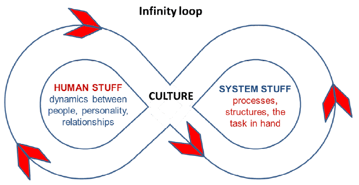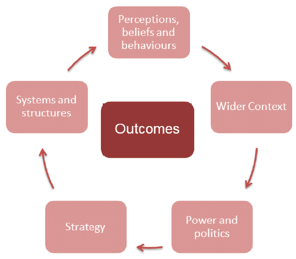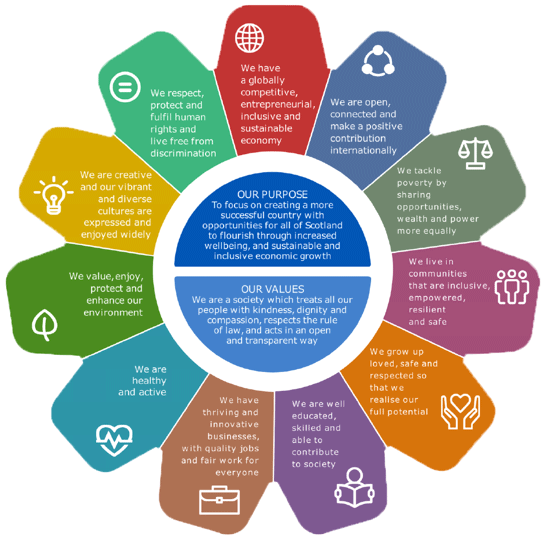Cultural issues related to allegations of bullying and harassment in NHS Highland: independent review report
An independent review report looking at cultural issues related to allegations of bullying and harassment in NHS Highland by John Sturrock, QC and mediator.
4. My Approach to Conducting the Review
"Clear is kind. Unclear is unkind...Feeding people half-truths or b……t to make them feel better (which is almost always about making ourselves feel more comfortable) is unkind."[2]
General
4.1. It was made clear from the outset that the review could not specifically address individual complaints or concerns, whether resolved or unresolved. I emphasised that the review's objective was to explore matters more generally. Those responding understood that readily. Of course, individual matters are very important as they represent experiences and examples to take into account in considering the overall situation in NHSH. I refer to a number of these to exemplify the issues raised.
4.2. I am not an expert in the workings of the NHS nor in allegations of organisational bullying. I am better informed now but I am more of a generalist than a specialist. That needs to be borne in mind by the reader. In order to inform myself better about the context of my review, I have taken into account a number of other reports and reviews. Some are specific to NHSH and others are more general, such as the reports by Sir Robert Francis in England[3] and the Bowles Report on NHS Lothian[4]. I have also been aware of the BMA's recent expressions of concern about bullying more generally in the NHS in Scotland[5] and of other reports commenting on bullying elsewhere.
4.3. However, I have endeavoured not to be unduly influenced by the fact or content of reports relating to matters elsewhere and to focus my attention on what has been and is said to be occurring specifically in NHSH. It will be for others to discern a pattern or to draw comparisons, if any, with what is happening elsewhere or more generally.
4.4. In forming views, I have listened extensively and tried to assess and distil what I (and my colleagues) have heard and read. I have noted the sources of information, and the apparent veracity of what has been said. I have been interested when multiple strands of information have come together and disclosed a trend or a theme. I have endeavoured to assess the credibility of what I have been told. The wide-ranging nature of the review has given me a substantial body of material to draw on. When making a statement of fact, I do so when I am satisfied that what I have heard and/or read reasonably entitles me to do so. Generally, however, I am reflecting the views expressed to me by others and have not sought to check every statement made for its factual accuracy.
Content
4.5. In accepting this appointment, I made clear that I would not conduct a form of inquiry in which I would find fault or allocate blame. However, inevitably, my report contains commentary which implies criticism of individuals in some cases. I cannot do justice to the many views expressed and the experiences so many have shared with me without doing so. This is unfortunate but it is an inevitable consequence of such a review.
4.6. I have not recorded all of the detail with which I was provided. That would have filled an even larger tome. Necessarily I have tried to acknowledge what I have heard and to assess the bigger picture. That also means that others will need to take forward and give effect, if they wish, to the specific proposals and suggestions which I make, and indeed develop these even more specifically.
4.7. There is a sense in which my review is more qualitative than quantitative, offering a broad analysis based on observations, meetings, and written submissions, without scrutinising every detail of every claim, situation or case brought to me nor placing precise numbers on all aspects. That provides a strong basis for initial understanding and insights and for a range of broad initial proposals.
4.8. As I mention above, the review is not forensic in the sense of testing every statement and assertion. More specific inquiry may be necessary in some areas and individual cases. Some of my suggestions may seem overly general, naïve or untested. Some proposals may already have been expressed or implemented elsewhere. So be it. Repetition may be useful. Reinforcement may be essential.
Confidentiality
4.9. There is a vast resource in the thoughtfulness and insights of NHSH staff. I am aware that I am privy to a very large amount of hugely helpful information about the workings of NHSH and I am concerned to try to ensure that the richness of what I have heard and read is not lost altogether when it might be useful to others. On the other hand, most of the information has been disclosed confidentially and I intend to respect that above all. In line with our undertaking to Scottish Government and our data protection responsibilities, data which we have gathered will be destroyed within two months of the publication of this report. I comment further on this in my proposals.
Getting Under the Surface
4.10. I have tried to approach this review with an open mind. I am very aware of the biases that affect us all (and I write more extensively about that later in the report), however careful we try to be. Many of these biases are unconscious and I need to accept that I cannot eliminate them wholly myself. I can only see through the glass darkly... and recognise that my own knowledge is imperfect. As has been said: "In human affairs there is no certain truth and all our knowledge is but a woven web of guesses."[6]
4.11. My own main bias may be that my life's work is to try to find ways to understand why conflict arises and remains unresolved in so many places in society - and to endeavour to help people find ways to overcome their differences and communicate effectively about what matters to them. In doing this, I may err on the side of trying to help or to fix things when my role is only to understand what is really going on and to make suggestions.
4.12. To take a possibly oversimplistic medical metaphor, I have been aware that there are many reported symptoms of a problem in NHSH which have been presented as bullying, and that one of my tasks, rather than merely accepting what appears on the surface, is to explore underneath and try to understand and diagnose the underlying causes of those symptoms.
4.13. In other words: What is happening? Why is it happening? What lies under the surface? What is really going on? And why? Only then can a general remedy or set of remedies be proposed for consideration and testing, after which it may be possible to prescribe a way forward in specific terms. This may be both restorative and preventative. What can be done to make things better? How can that be achieved? Why might that work better?
4.14. Even then, there may be a real need for trial and error until the best solution or solutions is found. It is unlikely that there will be easy fixes. Perseverance and patience will be required. To adopt a cliché, if the patient is really hurting, the application of a sticking plaster on the surface is unlikely to suffice.
4.15. Words from a report by the Organisation for Economic Co-operation and Development (OECD) resonate in NHSH:
"We're beyond quick fixes to address the discontent of people. There is no returning to the past. Too many things are not working for too many people. The only way forward is not to patch up …, but to shake it up.
We are confronting a similar foundational moment: one that demands decisive cures, rather than palliatives. These times require the same boldness, innovation, and above all, the long-awaited action to recreate, with our employees and stakeholders, a fair and prosperous future for all." [7]
Scotland's National Performance Framework
4.16. During my work on this review, I became aware of the details of the National Performance Framework (NPF). These are intended to guide public sector authorities in the conduct of their organisations. Social, economic and environmental indicators are designed to measure national wellbeing with a view to enabling all citizens to flourish. It is designed to be open, transparent and non-political and to encourage a shift from "business as usual". It draws attention to the complex interplay between the human stuff and the system stuff, illustrated as follows:

4.17. NPF recognises that we live in a VUCA world, one which is volatile, uncertain, complex and ambiguous:
The VUCA World
Volatility – The nature, speed, volume, magnitude, and dynamics of change
Uncertainty – the lack of predictability of issues and events
Complexity – The confounding of issues and the chaos that surrounds any organisation
Ambiguity – the haziness of reality and the mixed meanings of conditions
All of this is certainly true of the modern NHS and, as I have discovered, of NHSH.
4.18. The following further illustration shows the complexity of the world in which the NHS and other public bodies operate:

4.19. Among the values of the NPF are being a society which treats all our people with kindness, dignity and compassion, respects the rule of law, and acts in an open and transparent way. Among the expectations about how the National Outcomes will be achieved (see below), one particularly caught my attention, as I noted in the list of quotations which opened this report: "We grow up loved, safe and respected so that we realise our full potential". This should strike a chord as we explore what needs to happen in NHSH.
4.20. I have found all of this to be a helpful benchmark as I review what has happened in NHSH. It seems likely that NHSH will benefit from following the approach set out in the NPF as part of its leadership in the public sector in Scotland. The Purpose, Values and National Outcomes of the NPF are illustrated here:

Dignity
4.21. Above all, in conducting this review, I have been guided by the requirement to recognise that a sense of dignity is a fundamental need and right for all of us.
4.22. Donna Hicks has written eloquently …
"All human beings are unique; there is only one copy of us around. Something so precious deserves to be treated as invaluable, priceless, and irreplaceable. Yet, not a day goes by when we don't experience some kind of violation to our dignity—a rude remark, a critical tone of voice, a dismissive gesture intended to make us feel small. We all know the crushing and intolerable feeling of being shamed.
We human beings have an uncanny way of knowing how to psychologically hurt one another, and the attacks are always aimed at the most vulnerable aspect of our being—our dignity, our sense of worth. We share this vulnerability, just as we are all prone to physical attack and injury. Whether we are aware of it or not, when we inflict wounds on one another, they are meant to make us doubt the very core of who we are. They leave us with the question, "Am I good or am I bad?"
The truth about wounds to our dignity is that they don't go away. They accumulate within us until we do something radical, like scream at someone, walk off a job, leave a marriage, or start a revolution."[8]
4.23. I sense that these words will resonate with many of those in NHSH who engaged with this review - and with others too.
Contact
Email: john.malone@gov.scot
There is a problem
Thanks for your feedback